
A Trip to the Moon was a pioneering early dark ride, best known as the flagship and namesake of Luna Park in Coney Island, Brooklyn, New York City.

A Trip to the Moon was a pioneering early dark ride, best known as the flagship and namesake of Luna Park in Coney Island, Brooklyn, New York City.
A Trip to the Moon was originally designed by Frederic Thompson for the Pan-American Exposition of 1901 in Buffalo, New York. Tickets for the popular ride were US$0.50 ($16.00 in 2021 dollars [1] ) at the time, twice the price of other attractions at the exposition. It was experienced by over 400,000 people before it closed on November 2, 1901. [2] It was the first electrically powered mechanical "dark ride" and one of the first space rides. [3]
After the exposition, Thompson and his partner Elmer "Skip" Dundy brought the attraction to Tilyou's Steeplechase Park, then later established it as the anchor of their newly opened Luna Park in 1903, [4] on land formerly occupied by the Elephantine Colossus.

The first version of the ride involved a simulated trip for thirty passengers from the fairgrounds to the Moon aboard the airship-ornithopter Luna, with visions displayed of Niagara Falls, the North American continent and the Earth's disc. The passengers then left the craft to walk around a cavernous papier-mâché lunar surface peopled by costumed characters playing Selenites. There they visited the palace of the Man in the Moon and his dancing "Moon maidens", before finally leaving the attraction through a Mooncalf's mouth. After it was brought to Coney Island's Luna Park, the ride was revamped in a new building at a cost of $52,000. The ride's centerpiece was a ship called Luna III, enlarged to accommodate more passengers. Unlike its original Buffalo incarnation, the new version of the ride passed over a panorama of Coney Island and Manhattan's skyscrapers before rising into the clouds.

The Pan-American Exposition was a World's Fair held in Buffalo, New York, United States, from May 1 through November 2, 1901. The fair occupied 350 acres (0.55 sq mi) of land on the western edge of what is now Delaware Park, extending from Delaware Avenue to Elmwood Avenue and northward to Great Arrow Avenue. It is remembered today primarily for being the location of the assassination of United States President William McKinley at the Temple of Music on September 6, 1901. The exposition was illuminated at night. Thomas A. Edison, Inc. filmed it during the day and a pan of it at night.

Luna Park was an amusement park in Coney Island, Brooklyn, New York City. The park was located on a site bounded by Surf Avenue to the south, West 8th Street to the east, Neptune Avenue to the north, and West 12th Street to the west. Luna Park opened in 1903 and operated until 1944. It was located partly on the grounds of the small park it replaced, Sea Lion Park, "the first enclosed and permanent amusement park in North America", which had operated between 1895 and 1902. It was the second of the three original, very large, iconic parks built on Coney Island; the other were Steeplechase Park and Dreamland. At Coney Island's peak in the middle of the 20th century's first decade, the three amusement parks competed with each other and with many independent amusements.

Steeplechase Park was a 15-acre (6.1 ha) amusement park in Coney Island, Brooklyn, New York City. Steeplechase Park was created by entrepreneur George C. Tilyou in 1897 and operated until 1964. It was the first of the three large amusement parks built on Coney Island, the other two being Luna Park (1903) and Dreamland (1904). Of the three, Steeplechase was the longest-lasting, running for 67 years.
Dollywood's Splash Country is a 35-acre (14 ha) water park located in Pigeon Forge, Tennessee, adjacent to the Dollywood theme park. The park's central theme rests around entertainer Dolly Parton's childhood swimming in the rivers of the Great Smoky Mountains. Dollywood's Splash Country operates from May through September.

Burt Flickinger Center is a multipurpose indoor venue located in downtown Buffalo, New York.
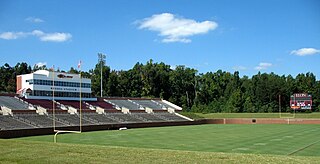
Rhodes Stadium is an 11,250-seat multi-purpose stadium in Elon, North Carolina. Named for trustee Dusty Rhodes, his wife, Peggy, and their family, the stadium opened in 2001 and is home to the Elon University Phoenix football team. The stadium also hosts soccer games on occasion.
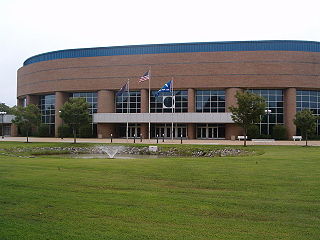
Hampton Convocation Center is a 7,200-seat multi-purpose arena in Hampton, Virginia. It was built in 1993 and is home to the Hampton University Pirates basketball team. The arena replaced Holland Hall gymnasium, which holds women's volleyball matches and tournaments. The construction cost was about $4 million-$5 million.

Joe Walton Stadium is a 3,000-seat multi-purpose stadium in Moon Township, Pennsylvania. It is home to the Robert Morris University Colonials football team and men's and women's lacrosse team. The facility opened in 2005 and is named for Colonials head football coach Joe Walton. The inaugural football game was played on September 17, 2005 when Robert Morris defeated Butler 49–13. The team formerly played its home games at Moon Area High School's Moon Stadium. The inaugural men's lacrosse game was played on March 5, 2005 when Robert Morris lost to Drexel 9–4. The inaugural women's lacrosse game was played on March 24, 2005 when Robert Morris lost to Wagner 16–3.

The Tennessee Tornado is a roller coaster at Dollywood amusement park in Pigeon Forge, Tennessee, United States. It debuted April 17, 1999, and was Dollywood's first major coaster expansion as well as one of Arrow Dynamics' last major coasters. The ride opened in a valley location previously occupied by Thunder Express, an Arrow Dynamics Mine Train roller coaster relocated from Six Flags St. Louis in 1989 and opened in 2002 at Magic Springs and Crystal Falls.

Riverbend Music Center is an outdoor amphitheater located in Cincinnati, Ohio, along the banks of the Ohio River. It has a capacity of 20,500 and was built for the Cincinnati Symphony Orchestra, to allow them to play in an outdoor venue during the summer months. Its location is directly adjacent to Coney Island water park and Belterra Park. Famed architect and 2012 Driehaus Prize winner Michael Graves designed the building. The venue is owned by the Cincinnati Symphony Orchestra, booked and operated by its subsidiary, Music and Event Management Incorporated (MEMI) and also partners with Live Nation.
White City is the common name of dozens of amusement parks in the United States, the United Kingdom, and Australia. Inspired by the White City and Midway Plaisance sections of the World's Columbian Exhibition of 1893, the parks started gaining in popularity in the last few years of the 19th century. After the 1901 Pan-American Exposition inspired the first Luna Park in Coney Island, a frenzy in building amusement parks ensued in the first two decades of the 20th century.

Mill Race was a log flume ride that operated between 1963 and 1993 at the Cedar Point amusement park in Sandusky, Ohio.

The Alltech Arena is a 5,517-seat multi-purpose arena in Lexington, Kentucky. The facility, named for the title sponsor Alltech, opened on the grounds of the Kentucky Horse Park in July 2009. It was originally constructed for the 2010 FEI World Equestrian Games.
The Seneca Road Company was formed to improve the main road running west from Utica, New York, the Genesee Road, from Utica to Canandaigua and operate it as a toll road or turnpike. The road was originally laid out in 1794 from Baggs Square in downtown Utica at the ford of the Mohawk River and followed the Indian trail past Syracuse to Canandaigua. Some accounts say it went to Geneva and Avon originally. There was no City of Syracuse then. The road became known as the Seneca Turnpike, which was 157 miles (253 km) long and, at the time, the longest toll road in the state.

Frederic Williams Thompson was an American architect, engineer, inventor, and showman known for creating amusement rides and one of the first large amusement parks.

Elmer Scipio "Skip" Dundy Jr. was an American showman and promoter known for creating amusement rides and one of the first large amusement parks.
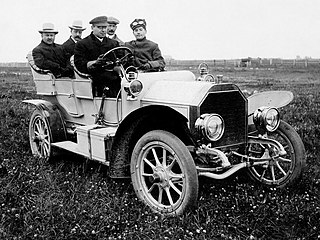
The Model S was the first four-seat passenger car produced by Oldsmobile in 1906, offered as a larger alternative to the Model R Curved Dash runabout that appeared in 1901. The advertised price was $2,250. It was Oldsmobile's first four cylinder car and took the top level marketing position above the Model L and the entry-level Model R. It was one of the last independently developed products before they joined General Motors in 1908, and competed against Buick, Ford and other automakers at the time. It was built at the Oldsmobile factory in Detroit and developed by Frederick and Angus Smith, whose father Samuel L. Smith was the primary investor, and R. E. Olds had left the company due to an argument with Oldsmobile Board of Directors.
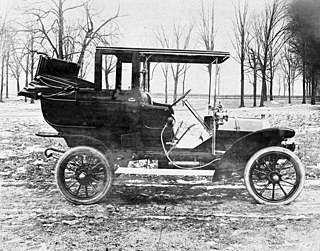
The Oldsmobile Model A was a passenger car manufactured by Oldsmobile for 1907 and it replaced the Model S while it was replaced by the Model M.
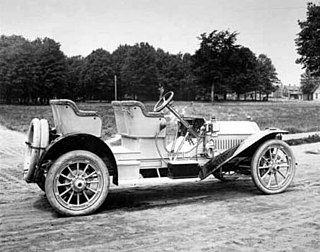
The Model M was a four-seat passenger car produced by Oldsmobile in 1908, offered as a mid-range alternative to the Model R Curved Dash runabout that appeared in 1901, replacing the Model A. It was the junior sedan to the first six-cylinder sedan called the Oldsmobile Model Z also introduced in 1908, but was larger than the Oldsmobile Model X.

The Model X was a four-seat passenger car produced by Oldsmobile in 1908, offered as an entry-level alternative to the Model D that appeared in 1901, replacing the Model M. It was the junior companion to the first six-cylinder sedan called the Oldsmobile Model Z also introduced in 1908, and shared most of its technology with the Model M.